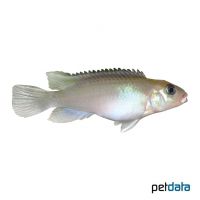Blue Congo Dwarf Cichlid (Nanochromis parilus)
| Blue Congo Dwarf Cichlid Nanochromis parilus | |
|---|---|
| Name | Blue Congo Dwarf Cichlid |
| Name Lat. | Nanochromis parilus |
| Family | Cichlids |
| Family lat. | Cichlidae |
| Order | Cichlids |
| Order lat. | Cichliformes |
| Origin | Congo |
| Habitat | Streams, rivers |
| Diet | Carnivore |
| pH | 6.0-7.0 |
| Behavior | Semi-aggressive |
| Keeping | Pair |
| Care Level | Moderate |
| Reproduction | Cave spawner |
| Breeding | Difficult |
| Life Span | 3-5 years |
| Protection | No |
| Metric Units | |
| Size | 7-8 cm |
| Temperature | 24-26 °C |
| Hardness | 1-8 °dH |
| Aquarium | 100 l |
| US Units | |
| Size | 2.8"-3" |
| Temperature | 75-79 °F |
| Hardness | 18-142 ppm |
| Aquarium | 25 gal |
Distribution and habitat
Blue Congo cichlids are common in the lower Congo River system in the Democratic Republic of Congo. They live in the low-flow marginal areas of the rapids between rocks and roots.
Maintenance
The aquarium should have border and background planting, with plenty of hiding places, such as stones, roots and caves (e.g. halved coconuts) as well as free swimming space. A dark gravel substrate covered with some foliage (sea almond tree, oak), some shaded light (floating plants) and soft, slightly acidic water with a medium current is ideal.
No ammonia, ammonium and nitrite should be detectable, the nitrate value should not exceed 100 mg/l. To ensure the water quality and oxygen content, a filter and heater adapted to the aquarium size is required, as well as lighting for the species-appropriate day-night rhythm of the animals.
Diet
In nature they feed on worms, small crustaceans and insects. The food supply consists of live or frozen cyclops, daphnia, artemia, black mosquito larvae, etc. or a commercially available frozen special food mix. High-quality, protein-rich dry food (flakes, granules, pellets, tablets) for cichlids is also well accepted, but should not be the main component of the diet.
It is recommended to feed small portions several times a day. Regular and varied feeding promotes health and prevents deficiency symptoms. Only as much should be fed as is eaten immediately (in a maximum of 10 minutes).
Behaviour and compatibility
They are relatively peaceful cichlids and should be kept in pairs. At spawning time the males are somewhat aggressive towards conspecifics. Keeping several pairs is only recommended in a larger and richly structured tank. They can be socialized well with other peaceful, not too large fish. Basically, only compatible fish species with similar demands on water quality and water temperature should be socialized.
Sex dimorphism
The females are more intensely colored, have a delicate purple belly and a clearly visible genital papilla even outside the spawning season. The somewhat larger males have a slightly longer, pointed dorsal fin.
Reproduction and breeding
They are cave breeders and usually attach the spawn to the cave ceiling or walls. The female performs brood care, while the male defends the territory (parental family). The fry hatch after 2-3 days and swim freely after 7-8 days. Both parents guard the fry for some time and lead them through the aquarium before the brood care ends.
Fry must be fed several times a day with special rearing food (Artemia nauplii). In community tanks breeding is hardly possible, because the fry are easy prey.
Important
They live in rivers with clear, brownish colored water rich in humic substances. Accordingly, the addition of peat extract or filtration through peat, as well as the use of foliage (sea almond tree, oak, etc.) is recommended to increase the well-being and color intensity of the fish. The foliage enriches the water with humic substances and naturally lowers the pH
In their range there are some differently colored site variants.
The well-being of the fish should be checked regularly. Temperature should be checked daily, pH, hardness and nitrate levels at least fortnightly. Regular partial water changes are recommended, even when contaminant levels have not yet reached the upper limit. Sudden changes in water quality should be avoided. Newly introduced fish must be accustomed slowly to the water in the aquarium.
Further literature can be found in your pet store.
References
Text: Werner Winter; Image: petdata
Source: BMELV (1998): Tierschutzgutachten - Haltung von Zierfischen (Süßwasser); RIEHL & BAENSCH (2004): Aquarien Atlas Bd. 1, Mergus Verlag; ENGELMANN (2005): Zootierhaltung - Tiere in menschlicher Obhut: Fische, Verlag Harri Deutsch
- Gemäß § 21 Abs. 5 Tierschutzgesetz idgF
